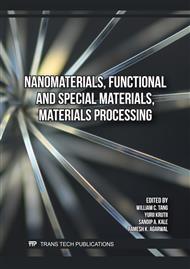[1]
Haleem, A., Khan, S., & Javaid, M. Composites in context to additive manufacturing. Lecture Notes on Multidisciplinary Industrial Engineering. (2021) 445–458.
Google Scholar
[2]
Ergene, B., & Bolat, C. Experimental study of test speed effects on tensile properties of PETG produced by additive manufacturing. International Journal of 3D Printing Technologies and Digital Industry, 6(1). (2022).
DOI: 10.46519/ij3dptdi.1069544
Google Scholar
[3]
Lakshman Sri, S. V., Karthick, A., & Dinesh, C. Evaluation of mechanical properties of 3D printed PETG and polyamide (6) polymers. Chemical Physics Impact, 8, 100491. (2024).
DOI: 10.1016/j.chphi.2024.100491
Google Scholar
[4]
Firtikiadis, L., Tzotzis, A., Kyratsis, P., & Efkolidis, N. Response surface methodology (RSM)-based evaluation of the 3D-printed recycled-PETG tensile strength. Applied Mechanics, 5(4), (2024) 924–937.
DOI: 10.3390/applmech5040051
Google Scholar
[5]
Guessasma, S., Belhabib, S., & Nouri, H. Printability and tensile performance of 3D printed polyethylene terephthalate glycol using fused deposition modelling. Polymers, 11(7), Article 1220. (2019).
DOI: 10.3390/polym11071220
Google Scholar
[6]
Eryıldız, M. Estimation of three-point bending behavior using finite element method for 3D-printed polymeric sandwich structures with honeycomb and reentrant core. European Mechanical Science, 6(3), (2022) 196–200.
DOI: 10.26701/ems.1101832
Google Scholar
[7]
Alarifi, I. M. Mechanical properties and numerical simulation of FDM 3D printed PETG/carbon composite unit structures. Journal of Materials Research and Technology, 23, (2023) 656–669.
DOI: 10.1016/j.jmrt.2023.01.043
Google Scholar
[8]
Kuchampudi, S. V., Meena, K. L., & Chekuri, R. B. R. An experimental investigation on 3D printing of PETG-KF-based composites: Optimization of process parameters for improved mechanical properties. Cogent Engineering, 11(1), Article 2379989. (2024).
DOI: 10.1080/23311916.2024.2379989
Google Scholar
[9]
Information on https://juggerbot3d.com/petg-filament-review/
Google Scholar
[10]
Dolzyk, G., & Jung, S. Tensile and fatigue analysis of 3D-printed polyethylene terephthalate glycol. Journal of Failure Analysis and Prevention, 19(2), (2019) 511–518.
DOI: 10.1007/s11668-019-00631-z
Google Scholar
[11]
Faidallah, R. F., Hanon, M. M., Vashist, V., Habib, A., Szakál, Z., & Oldal, I. Effect of different standard geometry shapes on the tensile properties of 3D-printed polymer. Polymers, 15(14), Article 3029. (2023).
DOI: 10.3390/polym15143029
Google Scholar
[12]
Hibbert K., Warner G., Brown C., Ajide O., Owolabi G., Azimi A. The Effects of Build Parameters and Strain Rate on the Mechanical Properties of FDM 3D-Printed Acrylonitrile Butadiene Styrene. Open Journal of Organic Polymer Materials, 9(1), (2019) 1–27.
DOI: 10.4236/ojopm.2019.91001
Google Scholar
[13]
Taresh O. F., Mezher M. T., Daway E. G. Effect of Infill Patterns and Densities on the Mechanical Properties of PETG Components Printed Using FDM. Results in Engineerin, 15, Article 100525. (2022).
DOI: 10.18280/rcma.330508
Google Scholar
[14]
Fernández-Vicente M., Calle W., Ferrandiz S., Conejero A. Effect of Infill Parameters on Tensile Mechanical Behavior in Desktop 3D Printing. 3D Printing and Additive Manufacturing, 3(3), (2016) 183–192.
DOI: 10.1089/3dp.2015.0036
Google Scholar
[15]
Valvez S., Silva A. P., Reis P. N. B. Compressive Behavior of 3D Printed PETG Composites, 9(124), Aerospace. (2022).
DOI: 10.3390/aerospace9030124
Google Scholar
[16]
Kutsyk S., Mikulich O., Feshchuk Y. Experimental Study of Material Anisotropy Effect for 3D Printing Elements. Materials Science Forum, 1141, (2024) 63–72.
DOI: 10.4028/p-xen66g
Google Scholar
[17]
Puspitasari E., Hadi S., Hartono M. Effect of Material Type, Temperature, and Layer Thickness on PLA and PETG from 3D Printer Products by Tensile Test. Proceedings of the 4th International Conference on Applied Science and Technology on Engineering Science (iCAST-ES 2021), 1, (2021) 572–580.
DOI: 10.5220/0010949300003260
Google Scholar
[18]
Tarfaoui M., Daly M., Kbaier R., Chihi M. Investigation of 3D printed CF-PETG composites' tensile behaviors: Synergizing simulative and real-world explorations. Composites Science and Technology, 247, Article 110385. (2024).
DOI: 10.1016/j.compscitech.2023.110385
Google Scholar
[19]
H. Sulym, Ia. Pasternak, S. Kutsyk, Stress concentration and effective mechanical properties of plates with doubly periodic systems of enforced holes, J. Visnyk TNTU 3(67), (2012) 7–16.
Google Scholar
[20]
Ali D., Huayier A. F., Enzi A. Parametric Prediction of FDM Process to Improve Tensile Properties Using Taguchi Method and Artificial Neural Network. Advances in Science and Technology. Research Journal, 17(4), (2023) 130–138.
DOI: 10.12913/22998624/169572
Google Scholar
[21]
Information on https://boze.com.ua/CoPET-PETg-ua/copet-petg-chornij-1kg-uk
Google Scholar
[22]
Sedlak, J., Joska, Z., Jansky, J., Zouhar, J., Kolomy, S., Slany, M., Svasta, A., & Jirousek, J. Analysis of the mechanical properties of 3D-printed plastic samples subjected to selected degradation effects. Materials, 16(8), 3268 (2023).
DOI: 10.3390/ma16083268
Google Scholar
[23]
DSTU ISO 6892-1:(2019)
Google Scholar
[24]
Information on https://en.wikipedia.org/wiki/Young%27s_modulus
Google Scholar
[25]
Information on https://en.wikipedia.org/wiki/Ultimate_tensile_strength
Google Scholar
[26]
Information on https://en.wikipedia.org/wiki/Deformation_(engineering)
Google Scholar
[27]
Gómez, J. M., Gómez, J. M., La Rubia, M. D., Mata-Garcia, E., Rodriguez-Santiago, M., & Martin-Doñate, C. Experimental and numerical analysis for the mechanical characterization of PETG polymers manufactured with FDM technology under pure uniaxial compression stress states for architectural applications. Polymers, 12(10), 2202 (2020).
DOI: 10.3390/polym12102202
Google Scholar


